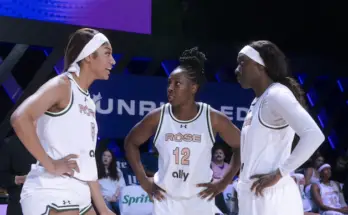When it comes to female athletes in America, there are many stories to be told. In this case, this story is of a clear contrast concerning race. A 2022 study conducted by Statista looked at the disparities in race among female student-athletes in America.
Here, the study uncovered that 69% of the athletes are White and only 9% are African American from the previous academic school year. Overall, the least represented races are Hawaiian/Pacific Islanders (0.3%), American Indian/Alaskan Natives (0.4%) and Asians (2.5%).
The ethnicity of female student-athletes in the United States in 2022
| Ethnicity | Percentage of female student athletes in the US |
| White | 68.90% |
| African American | 8.90% |
| Hispanic or Latino | 6.40% |
| 2 or more races | 5.10% |
| International | 4.80% |
| Other | 2.60% |
| Asian | 2.50% |
| American Indian/ Alaskan Native | 0.40% |
| Hawaiian/Pacific Islander | 0.30% |
Now, the disparity when it comes to female athletes reaching the professional level was discovered by Adidas when it came to the top 10 female athletes in America. The list showed that 70% of the athletes were white and 30% African American.
Ethnicity of America’s Most Popular Female Sport Stars
| US Sports Star | Sport | Ethnicity |
| Serena Williams | Tennis | African American |
| Simone Biles | Gymnastics | African American |
| Alex Morgan | Soccer | White |
| Megan Rapinoe | Soccer | White |
| Ronda Rousey | MMA | White |
| Lindsey Vonn | Skiing | White |
| Danica Patrick | Auto Racing | White |
| Ibtihaj Muhammad | Fencing | African American |
| Katie Ledecky | Swimming | White |
| Sue Bird | Basketball | White |
In this case, there is a lesser number of African American female athletes than white athletes, even at higher levels. It backed up the data shown earlier via Statista.
How Adidas is Addressing the Issue with Race and Female Athletes
To elevate the representation of ethnic minorities within sports, Adidas partnered with Black Women’s Player Collective (BWPC) to aid under-represented Black women and girls. The objective is to have better access to soccer, specifically building opportunities in under-funded communities.
Director of Culture and Communities for Adidas football, Gonzalo Calvo, addressed the union of Adidas with the BWPC:
“Since Adidas partnered with the Black Women’s Player Collective, we have worked towards giving underrepresented black women and girls the space they need to feel a sense of belonging in the world of soccer.
The BWPC is led by Black professional soccer players whose passion and purpose are to be champions for change. Their group is made up of seven board members, 38 members, and 15 crusaders. Additionally, it spans across ten professional teams and over five international premier teams
Adidas and its partnership is focused on making a long-term effect in under-funded communities. This is about creating a safe space for young African-American girls to have exposure to a playing field they can call their own.




